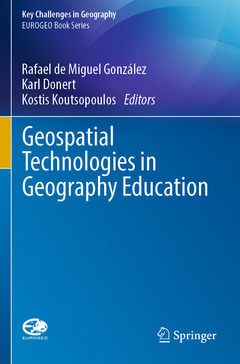Geospatial Technologies in Geography Education, 1st ed. 2019 Key Challenges in Geography Series
Coordonnateurs : de Miguel González Rafael, Donert Karl, Koutsopoulos Kostis

This book addresses new pedagogies focusing on the use of geospatial technologies and geomedia in the classroom. Today, geospatial technologies are substantially influencing geography teaching and learning, particularly in secondary education. Web-GIS, virtual globes, storytelling, maps and apps for mobile devices are transforming the nature and design of geography curricula, instructional processes, didactics, resources and assessments. Undoubtedly, geography is among those school subjects that have benefited most from the implementation of new technologies in the classroom. Geospatial technologies can be used to develop inquiry-based learning or project-based learning pedagogies and help students to acquire spatial reasoning and spatial citizenship skills in the context of education for sustainable development.
This book highlights a range of initiatives, projects and educational practices ? from several European countries and settings ? related to geospatial challenges in geography education. Given its scope, it will be equally appealing to scientists, students and teachers of geography and other fields using geospatial technologies and geomedia.
Part I: Spatial thinking and web-GIS.
Chapter 1: Infusing Educational Practice with Web GIS (Joseph J. Kerski and Thomas R. Baker)
Chapter 2: Spatial Thinking Ability Acquisition through Geospatial Technologies for Lifelong Learning (Alfonso García de la Vega)
Chapter 3: Geospatial thinking learning lines in secondary education: The GI Learner project (Luc Zwartjes and Maria Luisa de Lázaro y Torres)Chapter 4: Relational geospatial technologies and geospatial challenges of the XXI century (Viktor Chabaniuk and Leonid Rudenko)
Part II: Geospatial technologies for education in non-formal contexts
Chapter 5: YouthMetre: open data to empower young people and to engage youth people in democracy and policy making (Karl Donert, Rafael de Miguel González and Alessio Luppi)
Chapter 6: Contributions from Informal Geography to close the gap in Geographic Information communication in a digital world(Gerson Beltrán and Jorge del Río)
Chapter 7: EarthCaching as a possible way to raise environmental awareness? (Stefanie Zecha)
Chapter 8: Teaching geospatial competences by digital activities and e-learning. Experiences in geography, journalism and outdoor education (José Jesús Delgado Peña y María Purificación Subires Mancera)Part III: Geospatial technologies for education: practices and case studies
Chapter 9: Using computer games to mitigate disaffected emotions in the geography classroom. Lessons learned from small-scale research on teaching sustainable spatial planning with Minecraft (Mark Opmeer, Anne Faber, Eduardo Simão da Graca Dias and Henk Scholten)
Chapter 10: The Role of Geography and Geospatial Technologies in ‘Taking on the World’ (Mary Fargher)
Chapter 11: Geographies of the Anthropocene: Geoethics and Disaster Risk Reduction tools applied to Mediterranean case studies (Francesco De Pascale, Sebastiano D’Amico, Loredana Antronico and Roberto Coscarelli)
Chapter 12: GIS in secondary education in Hungary. Experiences in lessons and in a study group (Krisztina Dékány)
Examines new geospatial technologies used in geography education and informal education
Demonstrates how spatial information systems are implemented in educational practice
Discusses innovative approaches to geography education
Date de parution : 06-2020
Ouvrage de 219 p.
15.5x23.5 cm
Date de parution : 05-2019
Ouvrage de 219 p.
15.5x23.5 cm
Thème de Geospatial Technologies in Geography Education :
Mots-clés :
Geospatial Technologies; Geography Education; Webbased GIS; Educational Use of Computer Games; Informal Geography; Geospatial Challenges; Geographic Information Systems; Geospatial Competences; Cartography Education; EUROGEO; Geographical Learning; GST in education; Geomedia in the classroom



